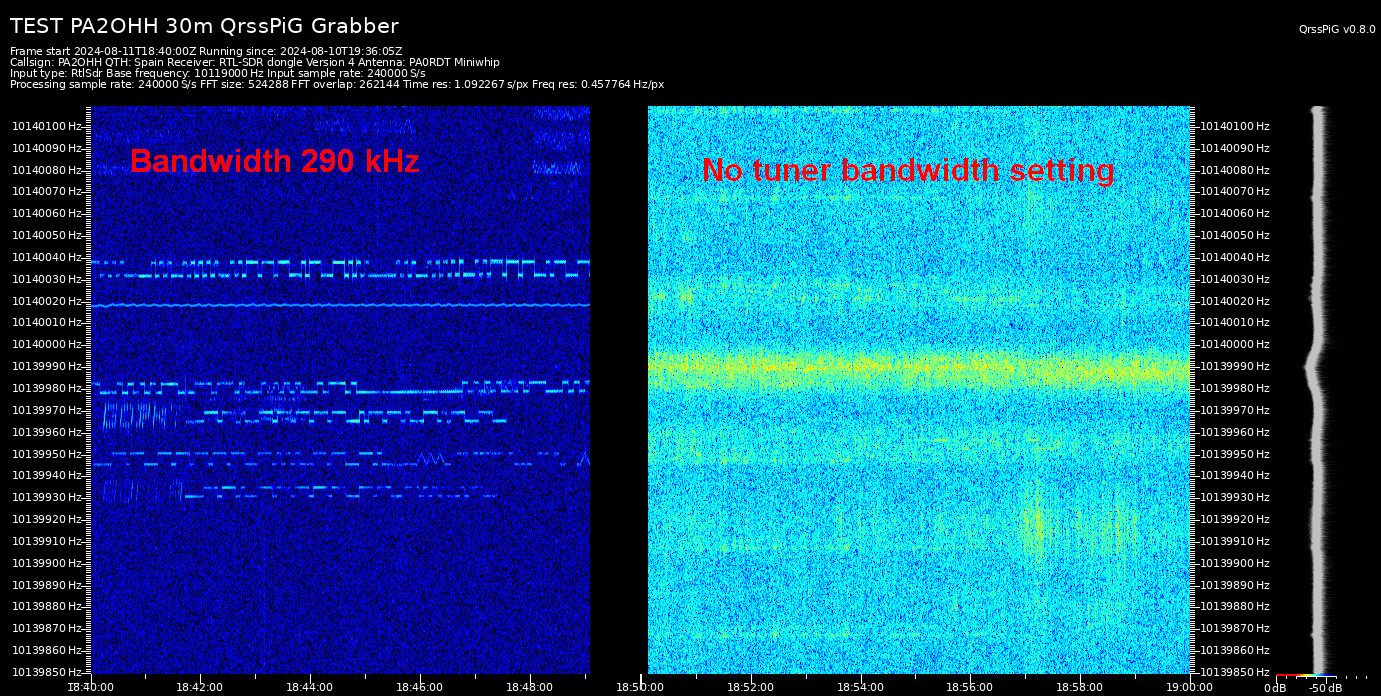QRSSPIG EXPERIENCES 2024
(2024)

Great QRSS reception with QrssPiG and a RTL-SDR dongle version 4!
Great QRSS reception with QrssPiG
As you can see above, QRSS reception with QrssPiG is a success! I use it with a PA0RDT miniwhip antenna and the sensitivity is good! But there were some issues and interesting experiences, good enough for a story on this website. I experienced for example that setting the bandwidth of the new Version 4 of the RTL-SDR-blog dongle is essential!
QrssPiG software is designed by Martin Herren and can be found on the following link:
https://gitlab.com/hb9fxx/qrsspig
It is a "headless" grabber, that means that it does not have a Graphical User Interface. All settings are edited and stored in a YAML file. But you do not have to wait the full 20 minutes to see the effect of the modified YAML file. Let QrssPiG run during 1-2 minutes with the new settings, stop it by pressing CTRL+C and a picture will be saved where you can see the effect of the modified settings. And you can add a note in a YAML file, text after a # on a line is a note.
However, there were some old obsolete links to his GitHub page and a for me important command "git clone" was missing. But that was not difficult to solve. How I did the installation for a Raspberry Pi can be found on the following link (also with YAML file examples).
IT IS EASY!
Link to ZIP file with my QrssPiG installation description
and YAML file examples
Now you are finished when you want to use QrssPiG with a normal audio output of a shortwave receiver!
But not when you want to use it with the new Version 4 of the RTLSDR-blog dongle like I wanted! Then you have to replace the driver. This new version 4 of the famous RTL-SDR blog dongle uses a built in upconverter instead of using a direct sampling circuit. So the reception on HF bands is much better than the previous version 3! Something confused me, there were more drivers available!
Driver 1: https://github.com/steve-m/librtlsdr
This is the original and official driver of Steve Markgraf that you have installed now, but it does not support the new Version 4 of the RTLSDR dongle. That may change in the (near?) future!
Driver 2: https://github.com/rtlsdrblog/rtl-sdr-blog
Modified Osmocom drivers with enhancements for RTL-SDR Blog V3 and V4 units.
Quick Start Guide at: https://www.rtl-sdr.com/qsg.
But... the selection of the tuner bandwidth by QrssPiG with it does not work. That may change in the (near?) future!
Driver 3: https://github.com/librtlsdr/librtlsdr/
This is a modified version of Driver 1. And it does support the new Version 4 of the RTLSDR dongle and also the tuner bandwidth setting. So this is the driver that I used. How to install it is given in the installation description. Now it is possible to set the tuner bandwidth to 290 kHz and that is a huge improvement as you can see on the picture below!

At the left with a tuner bandwidth of 290 kHz, at the right without tuner bandwidth set.
So it is very important to choose the tuner bandwidth as small as possible!
Why is the tuner bandwidth so important?
The tuner bandwidth is comparable with the IF bandwidth in a superhet receiver. If you do not set the bandwidth in the YAML file, the whole shortwave band is fed to the A/D converter instead of a narrow bandwidth part of 290 kHz around the reception frequency! What the effect is can be seen above on the picture. At the left a tuner bandwidth setting of 290 kHz, at the right no tuner bandwidth setting. It is obvious that it is really important to set that tuner bandwidth in the YAML file!

The antenna mast is not only used for antennas!
Lying in your hammock you can view the results with your tablet PC!!
Index PA2OHH



